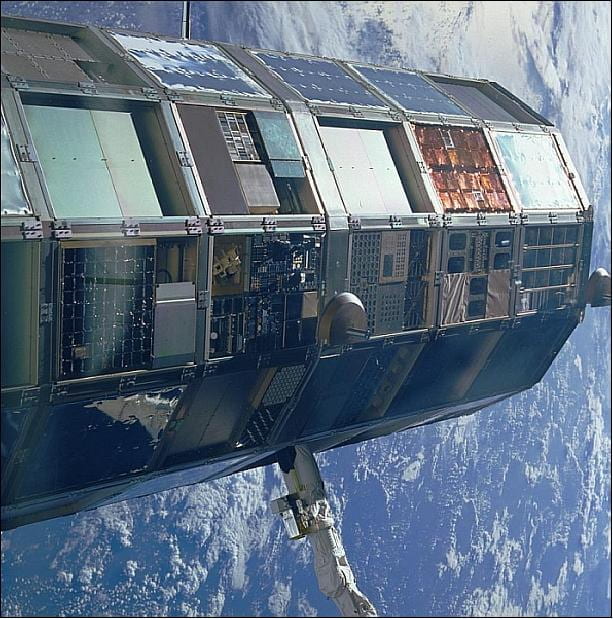The Long Duration Exposure Facility was a free structure implemented to take full advantage of the two way transportation capability of the Space Shuttle program. This satellite consisted of a number of technological experiments designed to collect information about long term exposure to the conditions of space and to collect information on the overall environment in low earth orbit (LEO). Among the topics and areas explored by LDEF were changes in material properties over time in the space environment, performance tests of spacecraft systems, component evaluations for spacecraft power, and chemical experiments in crystal growth.
Craft Overview:
The LDEF spacecraft was an open-grid, 12-sided, cylindrical structure on which a series of rectangular trays used for mounting experiment hardware were attached. The cylinder was 9.1 m in length and 4.3 m in diameter. LDEF was a gravity-gradient stabilized spacecraft, the longitudinal axis was pointing toward the center of the Earth. Surface elements were fixed relative to LDEF’s velocity vector. Magnetic actuators controlled the rotation around the longitudinal axis. The LDEF structure was configured with 72 equal-size rectangular openings on the sides and 14 openings on the ends (six on the Earth-facing end, and eight on the space-facing end) for mounting experiment trays. The craft’s total mass of spacecraft at deployment was 9,710 kg.
LDEF had no central power or data system; however, provide initiation and termination signals at the start and end of the mission. Any required power and/or data systems were included by the experimenter in each respective tray.
Deployment:
The LDEF was launched on the Challenger Space Shuttle (Shuttle STS-41-C) on April 6, 1984 from Cape Canaveral, FL, USA. The payload was deployed one day later on April 7th once Challenger reached the desired orbit. Upon deployment it was placed in a nearly circular orbit with average altitude of 477 km and inclination of 28.5 degrees. Over the nearly 6 year lifetime of the craft the orbit was seen to decay by over 100 km to 335 km when retrieved.
Recovery and Results:
Due to delays caused by the Challenger accident (STS-25), LDEF was finally recovered 69 months after launch on January 12, 1990 (STS-32) by the Space Shuttle Columbia. The Shuttle approached LDEF in such a way as to minimize possible contamination to LDEF from thruster exhaust. While LDEF was still attached to the RMS arm, an extensive 4.5 hour photo survey was performed that included photographs of each individual experiment tray, as well as larger areas of the craft. Special efforts were undertaken to ensure protection against contamination of the payload.
As a consequence of the delayed retrieval from orbit, much more data had been gathered than planned. Post mission de-integration occurred in the Spacecraft Assembly and Encapsulation Facility-II at NASA/KSC.
Sources and Additional Information:
- https://directory.eoportal.org/web/eoportal/satellite-missions/l/ldef
- A. S. Levine (editor), “LDEF – 69 Months in Space, First Post-Retrieval Symposium,” NASA Conference Publication 3134 (Part 1 and Part 2), Proceedings of a symposium sponsored by NASA at Kissimmee, Florida, June 2-8, 1991
- “The Long Duration Exposure Facility (LDEF), Mission 1 Experiments,” 1984. NASA SP-473, edited by L. G. Clark, W. H. Kinard, D. J. Carter Jr., J. L. Jones Jr., URL: http://ia600507.us.archive.org/1/items/nasa_techdoc_19840016564/19840016564.pdf
- “LDEF,” NASA/LaRC, URL: http://setas-www.larc.nasa.gov/LDEF/index.html
- W. K. Stuckey, “Lessons learned form the Long Duration Exposure Facility,” Feb. 15, 1993, URL: http://www.dtic.mil/cgi-bin/GetTRDoc?AD=ADA266026
- https://www.nasa.gov/centers/marshall/history/ldef01.html
| Acronym | LDEF |
| Full Name | Long Duration Exposure Facility |
| Size | 9.1 meters x 4.3 meters |
| Status | Recovered and Retired |
| Launch Date | April 7th, 1984 |

